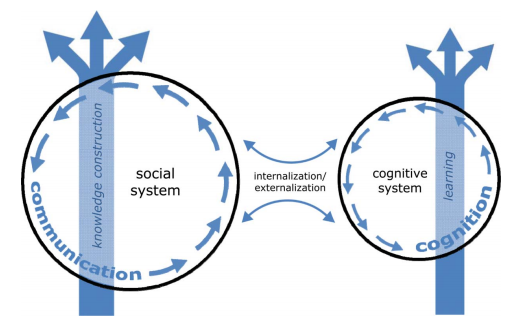e-Learning Ecologies MOOC’s Updates
Educational use of social media: individual learning through community interaction
Social media continues to wield influence on individual and community perceptions. More and more, people obtain their news and base their beliefs and values on what they read on Internet social media sites. Social media implies the use of web-based and media technologies to turn communication into an interactive dialogue. (Coen, 2016).
Consumers must apply digital literacy skills in order to examine the validity of what they see and hear, but in doing so, mold their understanding which, in turn, influences the knowledge that they share on the same websites or in personal conversations with friends or family. The social media model and its use of intrinsic motivation to engage participants can be leveraged for educational use.
Kimmerle (2015, p. 120) describes four processes of educational social media use: self-organization, internalization of information, externalization of knowledge, and the interplay of externalization and internalization providing the basis of a co-evolution of cognitive and social systems.
Self-organization implies activity. Participants begin with prior knowledge, but share ideas and challenge one another in an effort to obtain higher levels of understanding, not only for themselves, but with the potential that their sharing of knowledge can influence the understandings of others. Within Internet social media, large numbers of participants determine content within a general topic area, and are largely motivated to both consume and produce content through mutual benefit. Take Yelp.com or TravelAdvisor.com, where users read and write reviews of various restaurants or hotels. Participants benefit by expanding their understanding of others’ dining or lodging experiences and also desire to receive positive responses for well-written and helpful reviews themselves. Mutual benefits obtained from using the platform drives greater use, resulting in a better experience for consumers. It also challenges the establishments to improve achievement to achieve the better reviews.
Internalizing information comes from a process of reflecting on the nexus between prior individual understanding and new information the individual encounters. In the classroom, this is often where learning reaches its limits, and students are assessed on their effort to support these blended understandings.
Externalization of information engages participants in improving the collective knowledge of the community through sharing of individual understanding in the public forum. This is often replicated in more progressive classrooms, perhaps with a gallery walk, where members expand their individual understanding through observation and additional reflection on information obtained from peer research and modeling.
Where social media begins to reach critical mass, however, is in the kinetic movement of ideas as participants accelerate interactions, simultaneously internalizing and externalizing information over time. This dynamic process involves both the social system that comes from the community’s organization and the cognitive systems of each participant. Piaget’s concept of cognitive equilibrium becomes the engine of this process, as members work to resolve imbalances they encounter between prior knowledge and new discordant information, rapidly injected into the social media ecosystem (Kimmerle 2015, p.128).
Wikipedia is a frequently-searched, yet rarely-quoted source of community-constructed knowledge. Meghan Bogardus Cortez encourages educators and researchers to reconsider the merit of Wikipedia as a reliable source, Meghan Bogardus Cortez writes that Wikipedia itself discourages its use as a reliable source because, at any moment, content can contain errors, falsehoods, and inaccuracies. And while a Wikipedia article may not be reliable, it still represents a community understanding of the topic that is likely more comprehensive and representative than any other source (Cortez, 2019). I would also add that the recommended application of digital literacy skills such as checking multiple sources and applying critical thinking improve accuracy and also teach students the value of those skills when interacting with social media in their personal lives.
Kimmerle points out that education settings often lack ideal constructs for social media models for learning. Classrooms contain relatively few members with insufficient common interests to promote self-organizing in a way that holds meaning for individual learners. As a result, instructors continue to reinforce extrinsic motivation such as grades and teacher approval to drive deep work. Social media is best suited to informal settings with large groups of users. Also, learners are rarely invited to select learning that aligns with personal interest, but instead to teacher or institutionally-selected topics.
There is merit in considering that giving students more choice when learning, combined with the interactive internalization and externalization that occurs with social media, may help to break a cycle of disengaged learners who do not understand the relevance of their learning, and reinforcement strategies that conflict with our understandings of why humans learn. By employing social media-like systems through blended learning, a learning group “creates new understanding by taking up each other’s contributions and combining them into new insights.” (Kimmerle, 2015, p. 121). A community doesn’t easily change its knowledge, but each individual shares a new aspect, which influences the following contributions. Curiously, this does not mean that knowledge and beliefs will become more similar, but they do influence each others’ dynamics of change over time. (Kimmerle 2015 p. 129).
I see opportunity in applying Kimmerle’s four processes of social media use in an eLearning ecosystem. Even without the benefit of diversity and personal responsibility inherent to the Internet platforms, students can rethink their relationship with information, with others, and begin to experience an intrinsic satisfaction from contributing to the community’s learning as a whole. It is “crucial to conceive of knowledge as community property rather than the mental content of an individual” (Kimmerle 2015 p. 124).
Sources:
Cohn, M. (2016, March 24). Social Media vs Social Networking. Retrieved June 7, 2020, from https://www.compukol.com/social-media-vs-social-networking/#:~:text=The definition of social media,joined by a common interest.
Cortez, M. B. (2019, May 1). Should You Use Wikipedia as a Reliable Source? Scientists Think So. Retrieved June 7, 2020, from https://edtechmagazine.com/higher/article/2017/12/wikipedia-trustworthy-academic-resource-scientists-think-so
Kimmerle, J., Moskaliuk, J., Oeberst, A., & Cress, U. (2015). Learning and Collective Knowledge Construction With Social Media: A Process-Oriented Perspective. Educational Psychologist, 50(2), 120–137. doi: 10.1080/00461520.2015.1036273


